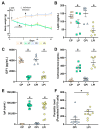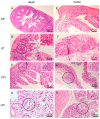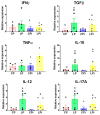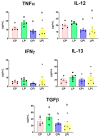Malnutrition Aggravates Alterations Observed in the Gut Structure and Immune Response of Mice Infected with Leishmania infantum
- PMID: 34207946
- PMCID: PMC8230684
- DOI: 10.3390/microorganisms9061270
Malnutrition Aggravates Alterations Observed in the Gut Structure and Immune Response of Mice Infected with Leishmania infantum
Abstract
Malnutrition is a risk factor for developing visceral leishmaniasis and its severe forms. Our group demonstrated that malnourished animals infected with Leishmania infantum had severe atrophies in lymphoid organs and T cell subpopulations as well as altered levels of thymic and splenic chemotactic factors, all of which resulted in dysfunctional lymphoid microenvironments that promoted parasite proliferation. Here, we hypothesize that malnutrition preceding parasite infection leads to structural and immunological changes in the gut mucosae, resulting in a failure in the immune response sensed in the intestine. To evaluate this, we analyzed the immunopathological events resulting from protein malnutrition in the guts of BALB/c mice infected with L. infantum. We observed lymphocytic/lymphoplasmacytic inflammatory infiltrates and lymphoid hyperplasia in the duodenum of well-nourished-infected mice; such alterations were worsened when malnutrition preceded infection. Parasite infection induced a significant increase of duodenal immunoglobulin A (IgA) of well-nourished animals, but those levels were significantly decreased in malnourished-infected mice. In addition, increased levels of Th17-related cytokines in duodenums of malnourished animals supported local inflammation. Together, our results suggest that the gut plays a potential role in responses to L. infantum infection-and that such responses are impaired in malnourished individuals.
Keywords: IgA; Leishmania infantum; duodenum; gut; inflammation; malnutrition; visceral leishmaniasis.
Conflict of interest statement
The authors declare no conflict of interest. The funders had no role in the design of the study; in the collection, analyses, or interpretation of data; in the writing of the manuscript, or in the decision to publish the results.
Figures









Similar articles
-
Thymus, undernutrition, and infection: Approaching cellular and molecular interactions.Front Nutr. 2022 Sep 26;9:948488. doi: 10.3389/fnut.2022.948488. eCollection 2022. Front Nutr. 2022. PMID: 36225882 Free PMC article. Review.
-
Proteomic profiling of splenic interstitial fluid of malnourished mice infected with Leishmania infantum reveals defects on cell proliferation and pro-inflammatory response.J Proteomics. 2019 Sep 30;208:103492. doi: 10.1016/j.jprot.2019.103492. Epub 2019 Aug 18. J Proteomics. 2019. PMID: 31434010
-
Thymic Microenvironment Is Modified by Malnutrition and Leishmania infantum Infection.Front Cell Infect Microbiol. 2019 Jul 12;9:252. doi: 10.3389/fcimb.2019.00252. eCollection 2019. Front Cell Infect Microbiol. 2019. PMID: 31355153 Free PMC article.
-
T-cell populations and cytokine expression are impaired in thymus and spleen of protein malnourished BALB/c mice infected with Leishmania infantum.PLoS One. 2014 Dec 23;9(12):e114584. doi: 10.1371/journal.pone.0114584. eCollection 2014. PLoS One. 2014. PMID: 25535967 Free PMC article.
-
Protein malnutrition promotes dysregulation of molecules involved in T cell migration in the thymus of mice infected with Leishmania infantum.Sci Rep. 2017 Apr 11;7:45991. doi: 10.1038/srep45991. Sci Rep. 2017. PMID: 28397794 Free PMC article.
Cited by
-
Upregulation of PD-1/PD-L1 and downregulation of immune signaling pathways lead to more severe visceral leishmaniasis in undernutrition mice.Parasit Vectors. 2024 Jan 8;17(1):8. doi: 10.1186/s13071-023-06018-2. Parasit Vectors. 2024. PMID: 38185681 Free PMC article.
-
Impact of Marasmic Malnutrition on Visceral Leishmaniasis: Progression and Treatment Efficacy in a Murine Model.Nutrients. 2025 Feb 28;17(5):849. doi: 10.3390/nu17050849. Nutrients. 2025. PMID: 40077719 Free PMC article.
-
Thymus, undernutrition, and infection: Approaching cellular and molecular interactions.Front Nutr. 2022 Sep 26;9:948488. doi: 10.3389/fnut.2022.948488. eCollection 2022. Front Nutr. 2022. PMID: 36225882 Free PMC article. Review.
References
Grants and funding
- P.C. Grant # VPPCB-007-FIO-18-2-74/FIOCRUZ - INOVA Program
- P.C. Emergentes grant # E-26/010.002168/2019/Fundação Carlos Chagas Filho de Amparo à Pesquisa do Estado do Rio de Janeiro
- P.C. JCNE E-26/201.545/2014 and JCNE E-26/203.253/2017/Fundação Carlos Chagas Filho de Amparo à Pesquisa do Estado do Rio de Janeiro
- Sediadas grant # E-26/010.101083/2018/Fundação Carlos Chagas Filho de Amparo à Pesquisa do Estado do Rio de Janeiro
- P.C. Universal grant No. 448007/2014-2/Conselho Nacional de Desenvolvimento Científico e Tecnológico
LinkOut - more resources
Full Text Sources
Miscellaneous

